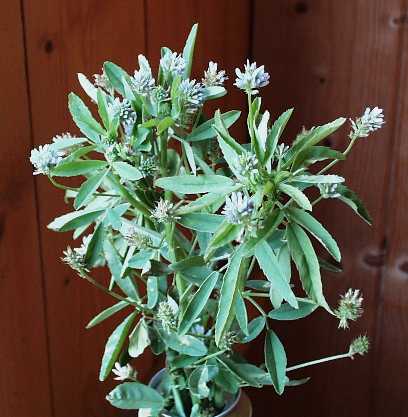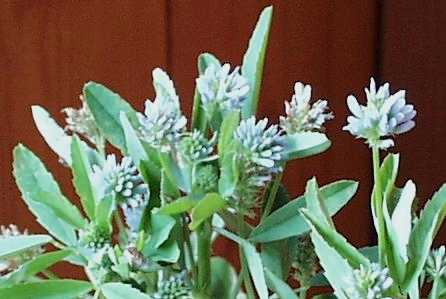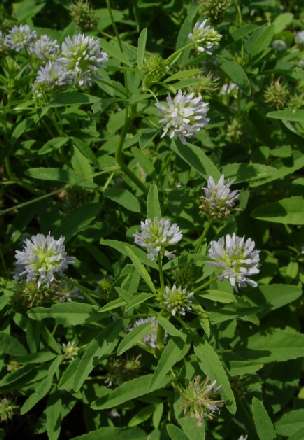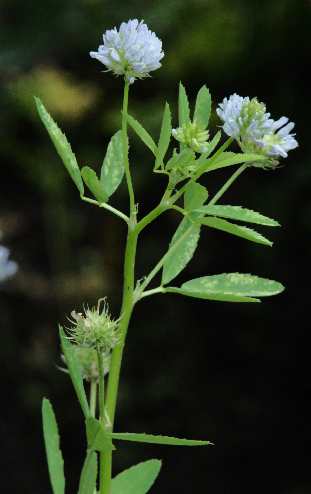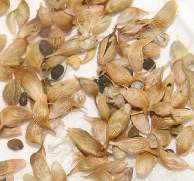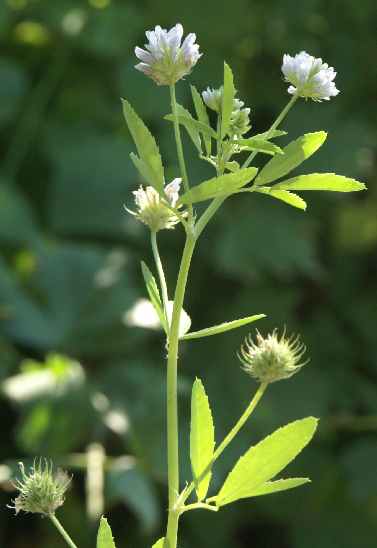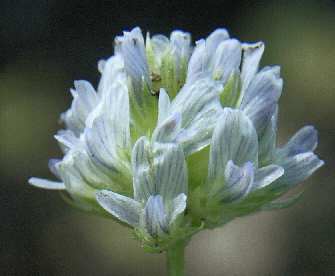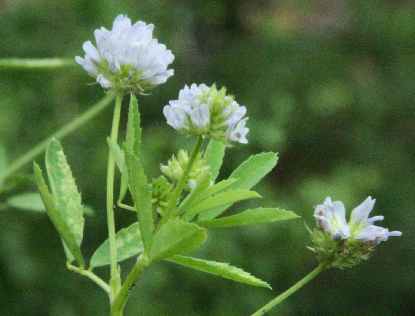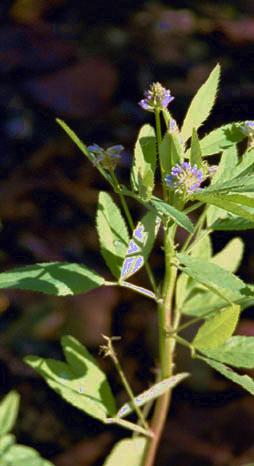
|
|
Blue fenugreek with flowers
© Daniel Landis
|
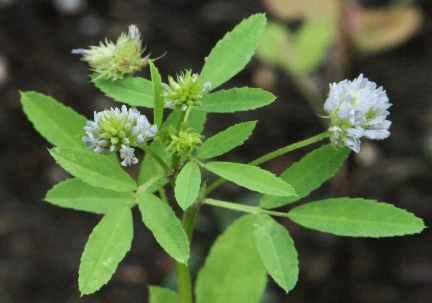
|
|
Flowers of blue fenugreek
|
Blue fenugreek is a culinary herb native to the Alps
in Central and Western Europe, and the Caucasus on the border between Asia and Europe; it is little known outside these regions.
In Georgia, the dried seeds of blue fenugreek are widely employed as a spice, usually sold as a pale greyish–brown powder
consisting of both pods and seeds. Because the plant grows only in the mountainous North of the country, it is not known to the
majority of Georgians, who live in the plains South of the Caucasus range; thus the spice is
named utskho suneli [უცხო სუნელი] foreign spice
.
Nevertheless, the spice is used throughout the country, but not beyond its borders, thus contributing strongly to the national character of Georgian food.
It is a common addition to stews and ragouts, as its flavour develops on prolonged cooking; in a strange way, it appears to intensify other flavours.
Ground blue fenugreek seeds are also part of the national herb mixture khmeli suneli
and form a key flavour in svanuri marili (see garlic), a spice salt from the Svaneti province in the High Coucasus mountains.
The cuisine of Georgia is particularly known for its subtle blends of herbs,
and for its pleasantly fruity, acidic, well-spiced sauces. Herbs
are usually employed in form of khmeli-suneli (dried herbs
,
also spelt xmeli-suneli and hmeli-suneli [ხმელი-სუნელი]).
That mixture is sold ground and may contain various herbs and spices, e. g., blue fenugreek,
savory, dill weed and
basil plus a smaller amount of
black pepper and a pinch of Imeretian
saffron (see safflower). Optional herbs are
parsley, mint
and coriander leaves.

| |
Flowers of blue fenugreek
|
|
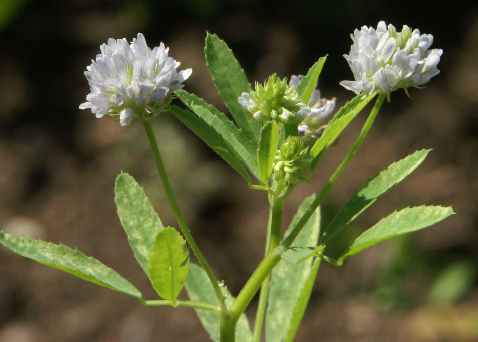
| |
Flowering blue fenugreek plant
|
|
Khmeli‑suneli is used for various Georgian meat and vegetable
stews and also for the many sauces Georgian cuisine is so famous for. These
sauces typically consist of dried herbs, acidic fruits and nuts.
A simple and well-known example is satsivi [საცივი],
a sauce made from ground walnuts and herbs used to dress cold boiled chicken meat. More
complex sauces are the plum-based t’q’emali sauce (see dill)
and the pungent ajik’a or
ajika [აჯიკა]
(Russian adzhika [аджика]).
Ajik’a is prepared all over the country, but particularly popular in Western Georgia and Abkhasia,
where Ottoman Turkish influence (and thus the love for spicy foods) is largest. It is made from fresh
chiles and paprika, aromatic fresh leaves
(celery, coriander),
garlic and khmeli-suneli and contains a large proportion of salt.

|
|
Flowering blue fenugreek plant
|
The national food of Georgia is skewered meats, mts’vadi (mtsvadi [მწვადი]),
which is more often known by its Russian name, shashlyk [шашлык].
It consists of bit-sized pieces of pork or mutton which are put on a metal spit and
grilled over open fire. It is served still on the spit, with raw onion rings
and various sauces for dipping, e. g., t’q’emali sauce, ajik’a or
a mild sauce made from raw tomatoes (sats’ebela [საწებელა]).
Blue fenugreek seeds are unavailable outside Georgia, and thus have to be replaced. Regular fenugreek seeds are
to strong and bitter; they should be mixed with dried fenugreek or blue fenugreek leaves to give an acceptable substitute.
In completely different form blue fenugreek makes an appearance in several Alpine foods: As a dried herb.
In the West Alps (Switzerland), it is added to a few cheese varieties, and in
the South Alps (South Tyrol) it lends a special flavour to local rye breads.
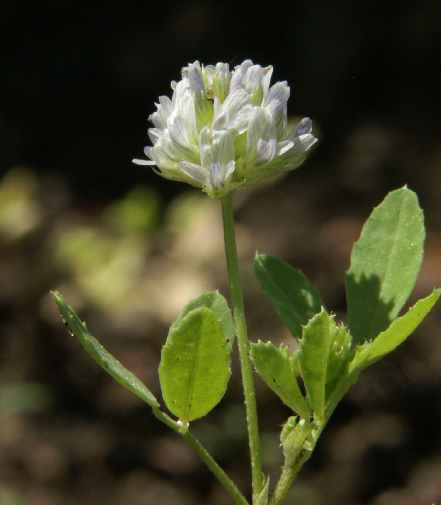
|
|
Flowering blue fenugreek
|
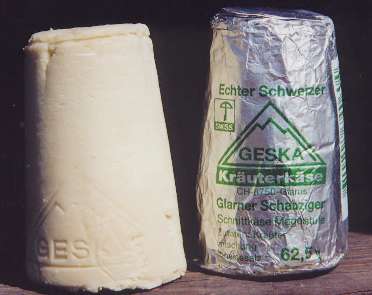
|
|
Swiss cheese flavoured with blue fenugreek
|
Cheese is produced in a wide area from Ireland to Central Asia, and from
Northern Africa to Norway; but the countries of Western and Central Europe
enjoy the greatest variety of cheese products. That has several reasons:
Production of milk has a tradition going back several millennia in these
thin-populated areas, and there is general tolerance for lactose in the
population; consequently, cheese is produced as a kind of preserved milk
that allows to store the nutritional value of milk protein.
Furthermore, in the Alps a large number of regional cheese traditions has
evolved due to geographic isolation.
Milk, essentially, contains two different types of proteins: Casein, which
precipitates when treated with acid or certain enzymes, and lactoglobulines,
(whey proteins) which are more soluble. Most cheese types consist only of the
former, which is precipitated, dried and then allowed to ripen in a fashion
characteristic for each cheese. Ripening is usually performed with bacteria,
often types which are local to a specific region; some cheeses, however,
are treated with molds (often of genus Penicillum); that procedure
leads to a particularly strong and characteristic aroma.

|
|
Flowering blue fenugreek
|
In cheese production, spices are of minor importance. There are some
soft cheeses flavoured with garlic or
pepper (usually green pepper), but other
spices are seen only rarely. In Southern Germany, there are local cheeses
spiced with caraway; I have read that
cumin is used for the same purpose in
Holland and France, but I have never seen such a cheese. Hungary, of course,
has some paprika-flavoured cheese varieties.
Fresh cheese, which has only a mild flavour, is often covered with dried
herbs (oregano, thyme),
particularly in the Mediterranean.
Lastly, some cheeses contain annatto seed extract
(bixin) as a colourant, e. g., British cheddar.
Cheese flavoured with blue fenugreek (Schabzigerkäse,
occasionally transcribed into English as sap sago cheese
) is a
specialty local to the region around Glarus, in the Swiss canton of the same
name. This cheese is twice ripened, ground, mixed with blue fenugreek powder
and then cast into its final shape. Blue fenugreek not only gives a
unique flavour, but also a pale green colour to this cheese.
Like most other hard cheese varieties, Schabziger is
mostly used as a flavouring: It is a tasty, unusual alternative to
Italian parmigiano for pasta dishes;
it can be used for several types of stuffings; or can be mixed with butter
to give a milder bread spread.
Blue fenugreek is not commonly used to
flavour other types of cheese, besides bread spreads based on cottage
cheese. It is, generally, not much used for foods prepared in
home kitchens, but rather an industrial spice hardly known to consumers; I don;t know even of commercial spice mixtures employing this rather exotic spice.
Yet it is occasionally called for in local Swiss foods, where it indeed makes good appearance: The herb powder is simply sprinkeled over
fried potatoes (Rösti) or potato-based caserolles. This seems to be restricted to a small part of Switzerland.
Independently, blue fenugreek appears in another specialty of the Alps,
namely South Alpine rye breads, whence the name Brotklee
(bread clover
). Ground blue fenugreek leaves are added in minute amounts
to the dough of rye breads in Tyrol and Southern Tyrol (which is part of
Italy, where it is referred to as Alto Adige).
These breads, already quite flavourful, acquire a unique taste from the
blue fenugreek. The herb is dried by a special procedure including a
fermentation step; therefore, it acquires a strong, characteristic aroma.
Rye breads (often referred to as dark or black breads) are a typical food of
the cooler regions of Europe, since rye thrives better than wheat in such
climate. Gluten, the protein that makes wheat flour dough elastic, is mostly
absent from rye, and consequently, rye bread is dense and less aired than wheat
bread; furthermore, they have a dark
, earthy flavour that anybody accustomed
to rye bread will miss when travelling through regions where only wheat bread
is baked. Because of their more intense base aroma, rye breads are quite
often flavoured with spices, e. g., pumpkin
seeds, coriander, fennel
or caraway fruits.
Outside of Central, Eastern and Northern Europe, bread is mostly produced from
wheat flour (white bread
); there are innumerable local varieties differing
in the composition of the dough, the fermentation procedure and additional
components (diary products, boiled potatoes, olive
oil). Wheat bread is often flavoured with nutty-tasting seeds sprinkled
over the surface before baking (poppy,
sesame); sometimes, the dough is enriched with
flavourings (fried onions, garlic). In the Eastern Mediterranean, bread
flavoured with mahaleb cherry stones is baked, and
Turkish breads often are sprinkled with nigella
seeds. In the Indian Himalayas, I have once eaten ajwain-sprinkled bread, but I think this was quite an
exception and not typical for cuisine in Ladakh.





